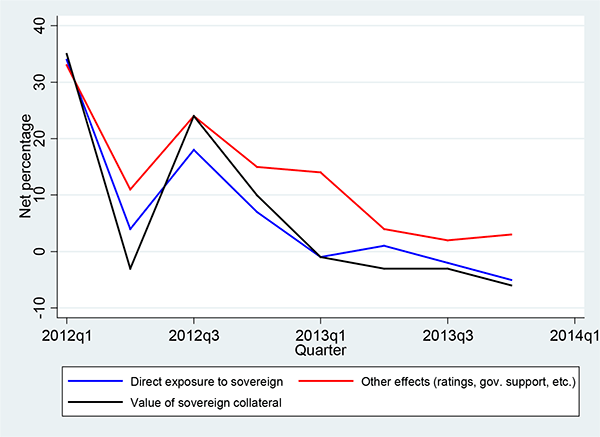The impact of sovereigndebt exposure on bank lending Evidence from the European debt crisis
Post on: 21 Август, 2015 No Comment

Figure 1 and 2 provide a first indication that exposure to impaired sovereign debt negatively affected bank lending in the wake of the European sovereign-debt crisis. The evolution of syndicated lending between 2007 and 2011 (Figure 1) shows that while global syndicated lending almost recovered to its pre-crisis levels by the end of 2011, the recovery in lending by European banks was much less pronounced. When we next compare lending by our sub-samples of affected and non-affected banks (Figure 2), we find no significant differences in the rate of change of syndicated lending by the two groups prior to 2010:Q4. However, after the crisis intensified with the Greek government securing a €110 billion bailout loan from the EU and the IMF in mid-2010, 3 loan growth by affected banks has been substantially lower than lending by non-affected banks.
Figure 1. Syndicated lending, 2007-2011
20horen%20fig1%205%20jul.png /%
Note. This figure shows the evolution of the total amount of syndicated loans issued worldwide in billion euros by all lenders in the market and by our sample of 34 European banks over the period 2007Q1 to 2011Q4. Only loans to non-financial corporates are included.
Figure 2. Impact of GIIPS sovereign-debt exposure on bank lending
20horen%20fig2%205%20jul.png /%
Note. This figure shows the evolution of total syndicated lending by our sample 34 European banks over the period 2009Q3 to 2011Q4. It depicts total volume (in euros) of syndicated loans isued in each quarter for the two groups of banks indexed to be 100 at 2010Q3. Only loands to non-financial corporates are included. Non-affected contains the group of banks whose exposure to GIIPS debt was below the median level and Affected contains the group of banks whose exposure was above the median level.
Our empirical analysis confirms that there indeed exists a direct link between deteriorating creditworthiness of foreign sovereign debt and lending by banks holding this debt on their balance sheet. When using our preferred econometric specification, we find that after 2010:Q3, affected banks increased lending 23.5% less than non-affected banks, suggesting that exposure to toxic GIIPS sovereign debt mooted the post-financial crisis recovery in syndicated lending. We show that this result is not driven by unobservable changes in borrower demand and/or quality, time-invariant bank characteristics or other shocks affecting the bank’s balance sheet. Furthermore, we rule out a large number of alternative explanations for our results.
When assessing how banks when exposed to impaired sovereign debt, rebalance their portfolio, we observe a reallocation away from foreign markets, especially the US, but not from core European ones. Furthermore, our results suggest that in the initial stages of the crisis carry trade-type behaviour by a number of banks loading on high-yield debt (see Acharya and Steffen 2013) may have arrested the slowdown in overall lending. Finally, we document that the slowdown in lending was lower for banks that reduced their debt holdings in the later stages of the crisis, pointing to potential positive effects of central bank asset-purchase programs.
What policy measures are most efficient in reversing the slowdown in bank lending in response to balance-sheet weakening induced by deteriorating sovereign debt? Two types of measures have been implemented since the start of the crisis:
- A consolidation of public finances in countries under stress in combination with loans by the EU and the IMF, and
- Various asset and liquidity operations by the ECB.

While the effectiveness of the former in reducing tensions in government bond markets is hotly debated, central bank policy in the later stages of the crisis has been perceived as relatively effective, even by some of its harshest critics during the early stages of the crisis.
Our results suggest that in the later stages of the crisis, asset purchases by the ECB may have arrested a slowdown in lending by allowing banks to reduce their overall exposures to impaired debt. While our paper provides evidence that exposure to impaired sovereign debt negatively affected the supply of bank credit, the verdict on the overall effect of the Eurozone crisis, as well as on policymakers’ success in resolving it, is still out.
Disclaimer: The views expressed in this column are those of the authors only and do not necessarily reflect the views of the ECB, De Nederlandsche Bank or the Eurosystem.
Bank of International Settlements (2011), The Impact of Sovereign Credit Risk on Bank Funding Conditions, CGFS Paper 43.
Gertler, M and N Kiyotaki (2010), Financial Intermediation and Credit Policy in Business Cycle Analysis in Friedman, B, and M Woodford (eds.), Handbook of Monetary Economics. Elsevier: Amsterdam, Netherlands
International Monetary Fund (2010), Sovereigns, Funding and Systemic Liquidity. Global Financial Stability Report Oct 2010.
International Monetary Fund (2012), Global Risk Analysis: Annex to Umbrella Report for G-20 Mutual Assessment Process.
Popov, A and N Van Horen (2013), The Impact of Sovereign Debt Exposure on Bank Lending: Evidence from the European Debt Crisis, DNB Working Paper 382.
1 BIS data suggest that banks’ exposure to the public sector of foreign countries ranges from 75% of Tier 1 capital for Italian and German banks to over 200% for Belgian banks (Bank for International Settlements 2011).
2 For example in the wake of the European sovereign debt crisis market counterparties (particularly US money market mutual funds) became concerned about the risk of lending to banks with significant exposures to sovereigns facing fiscal and growth pressures. This led to a sharp retraction of money market mutual funds’ exposure to European banks (International Monetary Fund, 2010).
3 This was followed by a €85 billion rescue package for Ireland in November 2010 and by a €78 billion rescue package for Portugal in May 2011.














